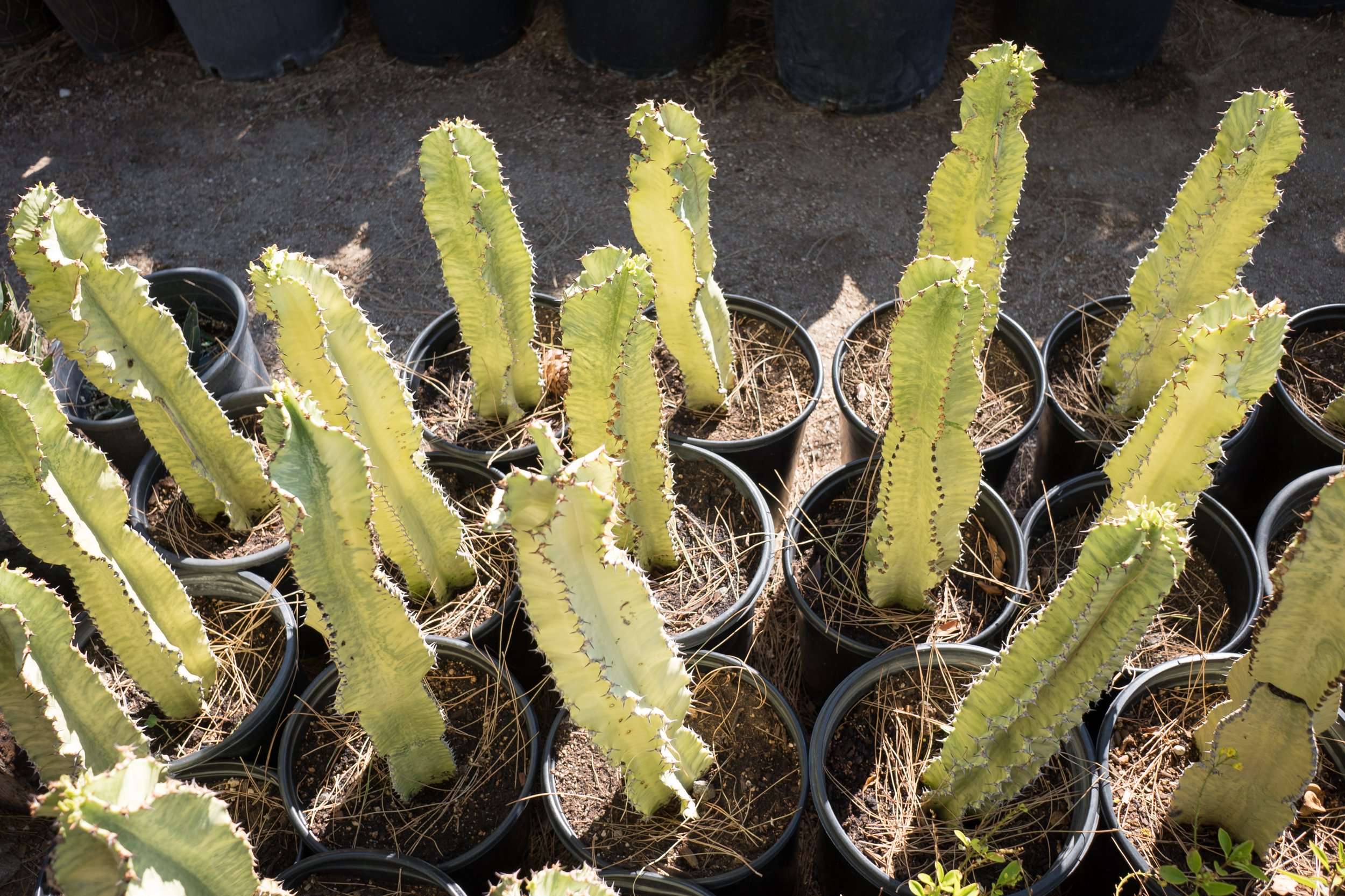Candelabra Cactus
Candelabra cactus sounds like a cactus and looks like one, but is actually a euphorbia. (Difference explained further down)
When small and very young, Candelabras give a fun and casual desert vibe with their stems that each form their own unique shape.
As they grow, they add a sophisticated look to the scenery with their tall and upright stature.
And when very mature, they turn into magnificent 30 foot trees- a very rare and magical sight for onlookers here in the US.
Botanical name: Euphorbia ingens
Other names: Dragon bones, Candelabra spurge, Candelabra tree, African candelabra, Cowboy cactus, Good luck cactus, Candle cactus, Candelabra euphorbia
Candelabra (Eurphorbia Ammak) Cactus for sale at the nursery
TABLE OF CONTENTS
Candelabra Cactus Appearance
Ingens in Latin means “massive” or “extraordinary,” and indeed, Euphorbia ingens can eventually become a massive 30 foot plus tree spreading equally as wide. However, it can take 20 years for the plant to reach that point under ideal conditions, making it accessible for many people to enjoy in smaller spaces for a long period of time.
This columnar, upright euphorbia grows out branches from the side of the trunk. Although the branches are quite irregular, giving each plant its own unique shape, overall, it stays upright and compact, giving it a clean look.
The green stems have 4-6 ridges that have very sharp spines.
Yellow-green flowers emerge from the top, attracting pollinators. Deep maroon fruit.
—————
A quick word on Euphorbias vs Cacti: Euphorbias, including the Euphorbia ingens, are often confused with cacti. Most euphorbias are from Africa, while most cacti are from the Americas. Even though they are not related, they have developed similar ways of surviving the heat and drought, hence the similarities.
The easiest way to tell the two apart are from looking at the spines. If you look closely at the Euphorbia ingens, you'll see that the stems themselves have thorny edges. If you cut it off, white poisonous sap can emerge. If you look at a cactus, you'll see that the spines grow from areoles independently, and you can cut off the spines without damaging the actual stem of the cactus.
—————
Candelabra Cactus Landscaping Tips
It is common to plant Euphorbia ingens as a main focal point in the landscape because as it matures, it spreads horizontally with each new branch it grows out, not to mention the eventual towering height it can reach.
If you desire multiple plants while maintaining a tidy appearance, we recommend planting each of them in large pots and keeping them pruned.
The spines are very short, but be aware that all parts of the candelabra cactus have poisonous, white sap.
Looks great in pots indoors. Once it grows to become a few feet tall, it will become a beautiful statement piece. Make sure it gets plenty of light if kept indoors.
Candelabra Cactus Origin
Candelabra Cactus is native to dry and warm areas of southern and south-eastern parts of Africa.
Candelabra Cactus Care
Care instructions for Euphorbia ingens is similar to that for most cacti. It requires warmth, sun, and well-draining soil. Be careful not to over water.
Soil: Loose, well draining soil that is lightly fertile.
Temperature: Can withstand temperatures down to 30 degrees for a short period of time. Does very well in heat.
Water: Occasional, deep watering. Allow the soil to completely dry out between waterings. Either use a moisture meter or stick your finger through the soil to gauge the moisture level. It’s better to err on the side of underwatering than overwatering.
Sun: Full sun to partial shade
5-gallon Candelabra (Euphorbia Ingens) being upsized to 15-gallons
Candelabra Cactus Problems
Pests: Euphorbias has minimal pests, which include mealybugs. To remove mealybugs, use insecticidal soap or apply rubbing alcohol directly to the area of infestation using a cotton swab.
Fungal diseases from root rot, dry rot, and harsh weather conditions.
Signs of overwatering: Drooping, squishy texture
Signs of too little water: Shriveling, drying skin
Signs of too much sun: Burning, scarring, fading color
Signs of too little sun: Etiolation, discoloring.
Candelabra Cactus Propagation
Propagate by using a blade to get cuttings. Use gloves since the white sap is poisonous. Wash off the sap and allow the cutting to dry so that the cut can be healed, which reduces the possibility of rot.
Once a callus has formed, usually after a few days, plant the cutting, and water it.
FAQ
How much does Candelabra cactus cost?
At our nursery, candelabra cactus costs $15 for a 1-gallon container, $45 for a 5-gallon container, $120 for a 15-gallon container, and $350+ for a 24" box.
Prices are subject to change. Please contact us for the most up-to-date information on pricing. We may have larger sizes available. We provide installation services locally at a separate cost.
Does candelabra cactus flower?
Yes, you will see small yellow-green flowers at the top when it blooms.
HOW TALL does Eurphorbia Ingens get?
Euphorbia ingens can eventually become a 30 foot plus tree if planted in the ground. However, it can take 20 years for the plant to reach that point.
Summary
| SIZE (H X W) | 10 feet |
|---|---|
| FLOWER COLOR | Yellow-green |
| FLOWER SEASON | Spring to Summer |
| EXPOSURE | Full Sun/Partial Shade |
| WATER | Low |
| GROWTH RATE | Fast |
| HARDINESS | 30º F, USDA Zone 10 |
| PRUNING | None |

